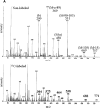Preparation of (13)C-labeled ceramide by acetic acid bacteria and its incorporation in mice
- PMID: 20656918
- PMCID: PMC2952581
- DOI: 10.1194/jlr.D009191
Preparation of (13)C-labeled ceramide by acetic acid bacteria and its incorporation in mice
Abstract
We prepared 2-hydroxypalmitoyl-sphinganine (dihydroceramide) labeled with a stable isotope by culturing acetic acid bacteria with (13)C-labeled acetic acid. The GC/MS spectrum of the trimethylsilyl derivative of (13)C-labeled dihydroceramide gave molecular ions with an increased mass of 12-17 Da over that of nonlabeled dihydroceramide. The fragment ions derived from both sphinganine base and 2-hydroxypalmitate were confirmed to be labeled with the stable isotope in the spectrum. Therefore, (13)C-labeled dihydroceramide can be an extremely useful tool for analyzing sphingolipid metabolism. The purified [(13)C]dihydroceramide was administered orally to mice for 12 days, and the total sphingoid base fractions in various tissues were analyzed by GC/MS. The spectrum patterns specific to (13)C-labeled sphingoids were detected in the tissues tested. Sphinganine pools in skin epidermis, liver, skeletal muscle, and synapse membrane in brain were replaced by [(13)C]sphinganine at about 4.5, 4.0, 1.0, and 0.3%, respectively. Moreover, about 1.0% of the sphingosine pool in the liver was replaced by [(13)C]sphingosine, implying that exogenous dihydroceramide can be converted to sphingosine. These results clearly indicate that ingested dihydroceramide can be incorporated into various tissues, including brain, and metabolized to other sphingolipids.
Figures






References
-
- Merrill A. H., Jr., Schmelz E. M., Dillehay D. L., Spiegel S., Shayman J. A., Schroeder J. J., Riley R. T., Voss K. A., Wang E. 1997. Sphingolipids–the enigmatic lipid class: biochemistry, physiology, and pathophysiology. Toxicol. Appl. Pharmacol. 142: 208–225. - PubMed
-
- Sawai H., Domae N., Okazaki T. 2005. Current status and perspectives in ceramide-targeting molecular medicine. Curr. Pharm. Des. 11: 2479–2487. - PubMed
-
- Rawlings A. V. 2003. Trends in stratum corneum research and the management of dry skin conditions. Int. J. Cosmet. Sci. 25: 63–95. - PubMed
-
- Imokawa G., Abe A., Jin K., Higaki Y., Kawashima M., Hidano A. 1991. Decreased level of ceramides in stratum corneum of atopic dermatitis: an etiologic factor in atopic dry skin? J. Invest. Dermatol. 96: 523–526. - PubMed
-
- Kim D. W., Park J. Y., Na G. Y., Lee S. J., Lee W. J. 2006. Correlation of clinical features and skin barrier function in adolescent and adult patients with atopic dermatitis. Int. J. Dermatol. 45: 698–701. - PubMed
MeSH terms
Substances
LinkOut - more resources
Full Text Sources
Miscellaneous
